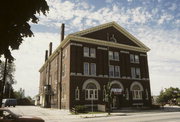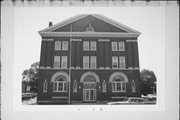| Additional Information: | A 'site file' exists for this property. It contains additional information such as correspondence, newspaper clippings, or historical information. It is a public record and may be viewed in person at the Wisconsin Historical Society, State Historic Preservation Office.
2009-
Dania Hall, constructed in 1905, is a three-story Neoclassical, gable-roofed building. The building is of red brick with
stone accents. The first story is marked with three large roman arches, into which are set the entrance doors, flanked by
triple-light arched windows. The first story is capped by a stone stringcourse and forms a plinth for four pairs of giant Ionic
pilasters at the second and third stories. The pilasters have stone bases and capitals and brick shafts. Two double hung
windows are present in each bay on each story. A recessed brick panel separates the second- and third-story windows.
The building is capped by a pediment with a small thermal window.
-"STH 38 (State Street) Survey," WisDOT ID #2290-12-00, Prepared by Justin Miller and Jennifer R. Harvey (2009).
Racine once claimed to be “the most Danish city in America.” Beginning around 1850, thousands of Danish immigrants settled here, many drawn by the prospect of factory jobs. At least two leading manufacturers, the J. I. Case Company (RA21), which recruited workers in Denmark, and the Mitchell Wagon Company, employed Danes almost exclusively. Nearly every sign on State Street bore a Danish name. The immigrants worked hard to preserve their Danskhed, or Danishness. This interest gave rise to formation of the Dania Society, founded in 1867 to promote Danish language study. Its hall also housed a library and hosted a choir, a dramatic club, and social functions.
Curiously, when the Dania Society needed a new hall in 1904, members chose a Beaux-Arts Classical design--at that time, the style most strongly associated with the American mainstream. The taste for colorful national styles was passé, and perhaps the society’s objectives had shifted toward cultural assimilation. Dania Hall’s classical features include symmetrical composition, arched windows with prominent stone heads, paired brick Ionic pilasters, and a bracketed pediment. Only the word "Dania" above the entrance reveals the ethnic association of this building, now a restaurant.
FULL PEDIMENT W/DENTICULATED CORNICE. 1/2 ROUND WINDOW W/KEYSTONE IN PEDIMENT. PAIRED ENGAGED IONIC COLUMNS ACROSS 2ND AND 3RD FLOORS. ROUND ARCHED WINDOWS AND ENTRY. SMALL WINDOWS W/KEYSTONES BETWEEN ARCHED 1ST FLOOR WINDOWS. |
|---|


